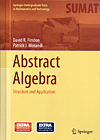- About MAA
- Membership
- MAA Publications
- Periodicals
- Blogs
- MAA Book Series
- MAA Press (an imprint of the AMS)
- MAA Notes
- MAA Reviews
- Mathematical Communication
- Information for Libraries
- Author Resources
- Advertise with MAA
- Meetings
- Competitions
- Programs
- Communities
- MAA Sections
- SIGMAA
- MAA Connect
- Students
- MAA Awards
- Awards Booklets
- Writing Awards
- Teaching Awards
- Service Awards
- Research Awards
- Lecture Awards
- Putnam Competition Individual and Team Winners
- D. E. Shaw Group AMC 8 Awards & Certificates
- Maryam Mirzakhani AMC 10 A Awards & Certificates
- Two Sigma AMC 10 B Awards & Certificates
- Jane Street AMC 12 A Awards & Certificates
- Akamai AMC 12 B Awards & Certificates
- High School Teachers
- News
You are here
Abstract Algebra: Structure and Application

Publisher:
Springer
Publication Date:
2014
Number of Pages:
187
Format:
Hardcover
Series:
Springer Undergraduate Texts in Mathematics and Technology
Price:
49.99
ISBN:
9783319044972
Category:
Textbook
[Reviewed by , on ]
Ellen Ziliak
06/2/2015
Many students in our abstract algebra courses are frustrated with the abstract nature of the standard presentations of this subject matter. Furthermore, students often perceive this course as irrelevant for their future careers. In Abstract Algebra: Structure and Application, Finston and Morandi intend to develop the structures and basic theorems of modern algebra through applications that have relevance to the students’ daily lives. Some of these applications include identification numbers like zip codes and UPCs, error-correcting codes, linear codes, ruler and compass constructions, cyclic codes, cryptography, and wallpaper patterns.
I have witnessed the struggle which motivated the authors to write this text in my own Abstract Algebra class. Students are now attending college in the belief that a college degree should provide direct training for a future career. Students want to know that it is worth their time to learn the material covered in a specific course. Often instructors get the question “When will I ever use this?” I still argue that the mathematics courses students are required to take will train them to take everyday problems and organize the information so they are able to use logic and previously developed theories to determine a solution. Sometimes, however, and especially in more abstract classes, it is useful to illustrate how others have used the material they are studying in practice.
The inclusion of examples such as Fermat’s Little Theorem allows instructors to argue that a theorem proven more than 350 years ago, well before the time of computers and the internet, is used today to protect our financial information when making purchases online. This shows students that sometimes applications are not readily available; but it is still useful to study this material because you never know what will be useful a few years down the road.
While I agree with the necessity of providing motivation for this course material, I think that the theory should motivate the examples, rather than the examples motivating the theory. At least for my students, that works better. That is why I teach undergraduate abstract algebra out of Abstract Algebra: an Introduction by Thomas W. Hungerford. This textbook is presented in a more traditional format but still contains many of the same applications presented in Finston and Morandi’s book.
When choosing between the two texts it is important to keep in mind your target audience. Finston and Morandi both described their typical student; one describes their students as math majors and secondary education mathematics majors, while the other’s students are pre-service or in-service teachers. For the vast majority of their students this will be their final abstract algebra course. The heavy emphasis on applications with the substantially less rigorous presentation of theory might make more sense for this audience. They delve deeper, providing more in-depth examples than what is provided in Hungerford. However the trade-off is a loss of the unifying themes of Abstract Algebra. The text does not emphasize the patterns that exist between various algebraic structures. Instead it seems often times theory is provided as an afterthought to explain why an application works.
In my own classroom I have fewer students planning to be future teachers, and far more students planning to go on to graduate school or into industry. For this population I think it is still important to motivate theory through the inclusion of applications, but developing a firm understanding of the structure and basic theorems of modern algebra is essential. For this population of students I believe Hungerford’s more traditional approach is better. Both books, however, do an excellent job of introducing students to the theory of abstract algebra and its applications. I believe students need to see how theory, even in a more abstract form, can be used in their everyday lives.
Ellen Ziliak is an Assistant Professor of mathematics at Benedictine University in Lisle IL. Her training is in computational group theory. More recently she has become interested in ways to introduce undergraduate students to research in abstract algebra through applications.
See the table of contents in pdf format.
- Log in to post comments




